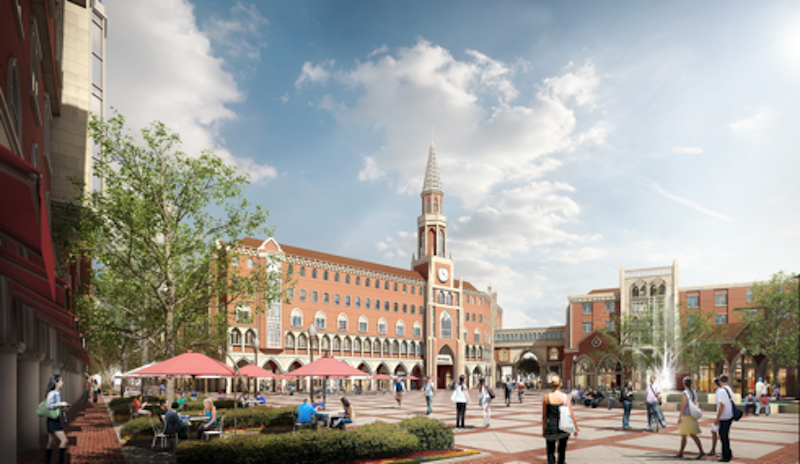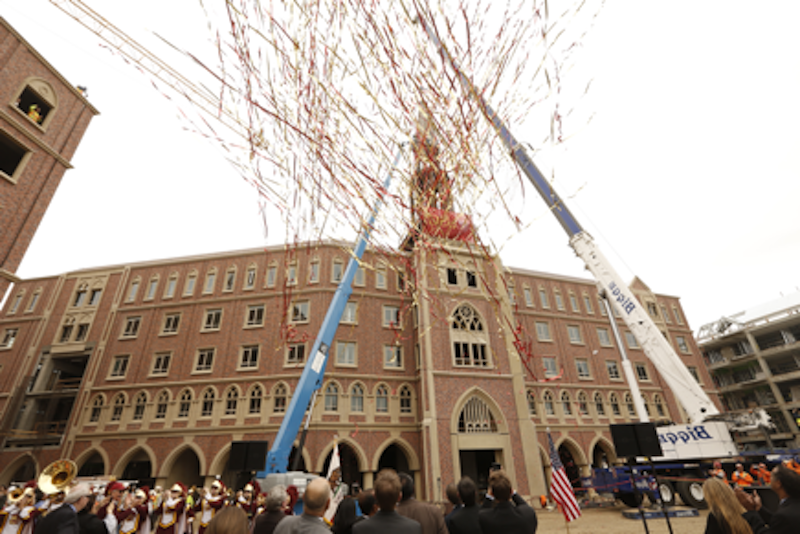This month, work crews began moving furniture, fixtures and equipment into USC Village, the biggest development project in the history of South Los Angeles, which is on schedule to be ready for the fall semester at the University of Southern California’s University Park campus.
The $700 million, 15-acre USC Village, which has been in the works since 2005, will consist of six buildings with a total of 1.25 million sf of space and 2,700 student beds. There will be eight residential colleges within USC Village, four of which had been endowed at presstime.
To view a flyover of the Village’s construction site, click here.
When USC Village was conceived, it was one of the first mixed-use residential college projects in the nation, and when completed it will include 100,000 sf of retail space for 30 tenants such as Bank of America, Starbucks, Target, and Trader Joe’s (which will be welcomed in South L.A. a food desert when it comes to supermarkets).
The Village will also have food and beverage outlets, and a 30,000-sf fitness center. The Village will provide 1,200 covered bike-parking slots, and another 500 slots for day-to-day bike parking by patrons of the gym or retail stores.
The exterior design of USC Village is best described as “collegiate gothic,” and reflects the mandate by USC’s president C.L. Max Nikias that the look of the Village be connected to the rest of the campus. “We could introduce any design feature, as long as it was gothic,” says Daniel Benjamin, AIA, LEED AP BD+C, Principal and Design Leader for Harley Ellis Devereaux, USC Village’s architect.
That meant a lot of detailing at the ground plane and roof level, but more traditional brick façade in the middle.
Benjamin notes that there weren’t enough masons in southern California to handle of project of this magnitude. So instead of importing workers from other parts of the state, the Building Team—which includes Hathaway Dinwiddie as the GC—decided to precast the concrete facades off site, typically delivered in 12- by 20-ft modules. Brick trimmed with sandblasted warm-colored concrete surrounds gives the buildings a three-dimensional sense of detail.
Prefabrication also cut the construction process, which began in June 2014, by nearly a year. These buildings are designed to last 80-100 years.
During the approval process, three major changes were made to USC Village’s plan, recalls Willy Marsh, USC’s director of construction. A large parking garage with a field on its roof became underground parking. High-rise residential towers became low-rise buildings. And a much larger retail center was de-emphasized. “The decision was made that retail wasn’t going to drive this project,” says Marsh.

The buildings' facade consists of precast concrete and brickface that mimics older buildings on campus. Image: USC
USC Village comprises about 20% of the University Park campus, and Nikias, says Benjamin, wanted the connections to be seamless. So the Village’s pathways and streets flow seamlessly into the larger campus’s circulation routes. More than 200 trees will be planted within and around the Village.
This campus is an integral part of the surrounding community. As part of this project, USC is providing $40 million in community benefits, including a $20 million contribution to an affordable housing fund that is managed by the city.
The number of student beds could increase to 5,000 if USC decides to redevelop a 12-acre lot adjacent to USC Village. Marsh says that project could be a decade away.
Related Stories
| Nov 3, 2010
First of three green labs opens at Iowa State University
Designed by ZGF Architects, in association with OPN Architects, the Biorenewable Research Laboratory on the Ames campus of Iowa State University is the first of three projects completed as part of the school’s Biorenewables Complex. The 71,800-sf LEED Gold project is one of three wings that will make up the 210,000-sf complex.
| Nov 3, 2010
Seattle University’s expanded library trying for LEED Gold
Pfeiffer Partners Architects, in collaboration with Mithun Architects, programmed, planned, and designed the $55 million renovation and expansion of Lemieux Library and McGoldrick Learning Commons at Seattle University. The LEED-Gold-designed facility’s green features include daylighting, sustainable and recycled materials, and a rain garden.
| Nov 3, 2010
Recreation center targets student health, earns LEED Platinum
Not only is the student recreation center at the University of Arizona, Tucson, the hub of student life but its new 54,000-sf addition is also super-green, having recently attained LEED Platinum certification.
| Nov 3, 2010
Virginia biofuel research center moving along
The Sustainable Energy Technology Center has broken ground in October on the Danville, Va., campus of the Institute for Advanced Learning and Research. The 25,000-sf facility will be used to develop enhanced bio-based fuels, and will house research laboratories, support labs, graduate student research space, and faculty offices. Rainwater harvesting, a vegetated roof, low-VOC and recycled materials, photovoltaic panels, high-efficiency plumbing fixtures and water-saving systems, and LED light fixtures will be deployed. Dewberry served as lead architect, with Lord Aeck & Sargent serving as laboratory designer and sustainability consultant. Perigon Engineering consulted on high-bay process labs. New Atlantic Contracting is building the facility.
| Nov 3, 2010
Dining center cooks up LEED Platinum rating
Students at Bowling Green State University in Ohio will be eating in a new LEED Platinum multiuse dining center next fall. The 30,000-sf McDonald Dining Center will have a 700-seat main dining room, a quick-service restaurant, retail space, and multiple areas for students to gather inside and out, including a fire pit and several patios—one of them on the rooftop.
| Nov 1, 2010
John Pearce: First thing I tell designers: Do your homework!
John Pearce, FAIA, University Architect at Duke University, Durham, N.C., tells BD+C’s Robert Cassidy about the school’s construction plans and sustainability efforts, how to land work at Duke, and why he’s proceeding with caution when it comes to BIM.
| Oct 13, 2010
Editorial
The AEC industry shares a widespread obsession with the new. New is fresh. New is youthful. New is cool. But “old” or “slightly used” can be financially profitable and professionally rewarding, too.
| Oct 13, 2010
Campus building gives students a taste of the business world
William R. Hough Hall is the new home of the Warrington College of Business Administration at the University of Florida in Gainesville. The $17.6 million, 70,000-sf building gives students access to the latest technology, including a lab that simulates the stock exchange.
| Oct 13, 2010
Science building supports enrollment increases
The new Kluge-Moses Science Building at Piedmont Virginia Community College, in Charlottesville, is part of a campus update designed and managed by the Lukmire Partnership. The 34,000-sf building is designed to be both a focal point of the college and a recruitment mechanism to get more students enrolling in healthcare programs.
| Oct 13, 2010
Residences bring students, faculty together in the Middle East
A new residence complex is in design for United Arab Emirates University in Al Ain, UAE, near Abu Dhabi. Plans for the 120-acre mixed-use development include 710 clustered townhomes and apartments for students and faculty and common areas for community activities.
















